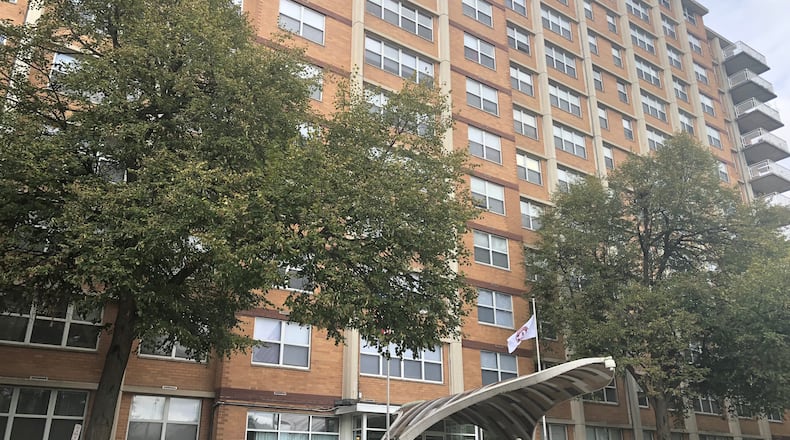Rents are expected to rise but will depend on the strength of the market and will be competitive, especially at JP Flats, Lindy President Alan Lindy said.
The company will own three prominent apartment buildings that offer a nice range of product and price points, Lindy said.
Rents “will be less than new construction, but hopefully they’ll be more than where they are today,” he said.
Some residents and other groups say they are worried about losing more affordable rental units at a time when much of the growth in housing has been high-end apartments.
“I would love to continue to stay where I’m at, but to me if they try to go up on the rent, it’s going to be a little steep,” said Dillard Brown, 63, who has lived at the Dayton Towers for about a year.
Lindy Communities, which has about 35 properties in multiple states, entered the Dayton market about eight years ago with the purchase of the St. Clair Lofts.
The company, based in a Philadelphia suburb, paid nearly $3.2 million for the apartment building, which has 108 units and sits just west of the Oregon District.
Last month, Lindy bought the 14-story Dayton Towers for about $13.5 million. Dayton Towers, built in 1963, is at 425 Dayton Towers Drive, east of the Oregon business district.
Lindy says it will renovate the Dayton Towers’ common spaces, amenities and outside landscaping, which should be done within a year, Lindy said. The property also will be renamed the View at Dayton Towers.
Apartment units will be renovated as they turn over, and improvements will include new kitchens, flooring, lighting, finishes and possibly bathroom upgrades, Lindy said. Kitchens should get new quartz or granite counters.
Right now, the tower is about 85 percent occupied.
Lindy purchased 7.6 acres, which includes a lot of vacant grassy land around the high-rise building.
Lindy plans to redevelop the vacant land to add amenities, a club house and other garden-style apartments, Lindy said.
Lindy hopes to close this month on the JP Flats, which is a seven-story apartment building at the corner of North Jefferson and East Second streets.
Following renovations, the building will have around 50 apartments.
Like the Dayton Towers, the renovations also will take place as units turn over, which means the work might take a few years to complete, Lindy said.
The market and public will determine the rents, but naturally the hope is to be able to get higher rents after the upgrades, Lindy said.
The previous owner renovated some apartments in the Dayton Towers, which have fetched higher rents, he said.
“They’ve been getting a fairly decent differential on them,” he said.
The JP Flats apartments are smaller, and even after renovation, they still will be more moderately priced, Lindy said.
The JP Flats will be designed to be open, contemporary and have light colors, Lindy said.
“I think it will appeal to people who want to live in the city in a community that’s new and a little more affordable,” Lindy said.
Lindy said he expects some residents of both buildings will move into renovated units when they get a chance, freeing up their units for upgrades. He said housing-seekers will have a nice diverse range of housing options between Lindy’s three apartment communities.
But Lindy’s acquisition of the apartment buildings has some residents worried rents will climb out of their price range.
Brown, who lives at the towers, said his current rent is quite reasonable, which is $800 for a one bedroom and includes the cost of utilities.
But Brown said he is willing to move if the rent goes up significantly because it simply would be too much money.
Brown said the Dayton Towers needs a lot of work, and he’s glad the new owners plan to make it a better place to live.
He said the building has some older residents and the elevators are old and sometimes malfunction. He said the maintenance could be better.
Mick Kennedy, who is only living at the towers temporarily, said his unit is old and definitely needs sprucing up.
Kennedy, 65, said he hopes the building remains affordable moving forward because it is a good deal since they pay the utilities, accept pets and keep up on the maintenance. He pays $790 per month.
“Some people have lived here 30 years,” he said.
Many landlords are upgrading their units and increasing their rents partly in response to a big shift from homeownership to rental housing, said Marcus Roth, development director with the Coalition on Homelessness and Housing in Ohio.
The homeownership rate plunged to 66 percent in 2017 from nearly 75 percent in 2005, as retiring baby boomers and middle-class millennials opted to rent instead of buy housing, he said.
This spiked demand for rental housing, and the market primarily responded by building a lot of high-end apartments, while the supply of less expensive apartments declined, he said.
But Downtown Dayton Partnership President Sandy Gudorf said the downtown area has apartments that span a healthy range of prices, and Lindy itself has three housing options at varying prices.
People of all income levels have housing choices in the downtown areas, because there are studios, smaller units and other options that have more modest price points, she said.
There’s some modestly priced rentals on the upper floors of commercial buildings in Oregon District.
A market study by the partnership noted that prices at the Oriel Studios started at $500. Its smallest unit is around 330 square feet. Most of the major apartment buildings in and around downtown start in the low- to mid-$700 range.
“We have many options — definitely more so on the rental side than the condominium side,” Gudorf said.
About the Author

